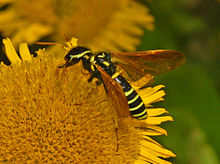| Megalodontesidae | |
|---|---|

| |
| Megalodontes sp. | |
| Scientific classification | |
| Domain: | Eukaryota |
| Kingdom: | Animalia |
| Phylum: | Arthropoda |
| Class: | Insecta |
| Order: | Hymenoptera |
| Suborder: | Symphyta |
| Superfamily: | Pamphilioidea |
| Family: | Megalodontesidae Konow, 1897 |
| Genera | |
|
See text | |
| Synonyms | |
|
Praesiricidae Rasnitsyn, 1968 | |
The Megalodontesidae (until recently spelled Megalodontidae,[1] a name already in use for a family of fossil molluscs) are a small family of sawflies, containing a single living genus, Megalodontes, with some 40 species restricted to the temperate regions of Eurasia. Larvae of Megalodontesidae feed on herbaceous plants. They are distinguished from the closely related Pamphiliidae by their serrate or pectinate antennae.[2]
In 2016, a phylogenetic analysis of the superfamily Pamphilioidea found that the extinct family Praesiricidae was paraphyletic with respect to Megalodontesidae, so Praesiricidae was proposed as a synonym of Megalodontesidae.[3]
- ^ International Commission on Zoological Nomenclature (1996). "Opinion 1829. Megalodontidae Konow, 1897 (Insecta, Hymenoptera): spelling emended to Megalodontesidae, so removing the homonymy with Megalodontidae Morris & Lycett, 1853 (Mollusca, Bivalvia)". Bulletin of Zoological Nomenclature. 53 (1): 66–67.
- ^ Hymenoptera of the world : an identification guide to families. Goulet, Henri., Huber, John T. (John Theodore), Canada. Agriculture Canada. Research Branch. Ottawa, Ont.: Centre for Land and Biological Resources Research. 1993. ISBN 0-660-14933-8. OCLC 28024976.
{{cite book}}: CS1 maint: others (link) - ^ Wang, M.; Rasnitsyn, A.P.; Li, H.; Shih, C.; Sharkey, M.J.; Ren, D. (2016). "Phylogenetic analyses elucidate the inter-relationships of Pamphilioidea (Hymenoptera, Symphyta)". Cladistics. 32 (3): 239–260. doi:10.1111/cla.12129.